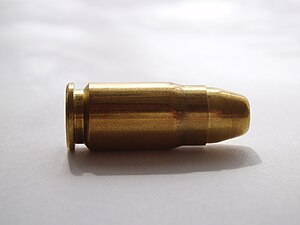357SIG
| .357 SIG | ||||||||||||||||||||||||
|---|---|---|---|---|---|---|---|---|---|---|---|---|---|---|---|---|---|---|---|---|---|---|---|---|

.357 SIG jacketed flat point cartridge
|
||||||||||||||||||||||||
| Type | Pistol | |||||||||||||||||||||||
| Place of origin | Switzerland United States |
|||||||||||||||||||||||
| Production history | ||||||||||||||||||||||||
| Designer | SIGARMS / Federal Cartridge Co. | |||||||||||||||||||||||
| Designed | 1994 | |||||||||||||||||||||||
| Produced | 1994–present | |||||||||||||||||||||||
| Specifications | ||||||||||||||||||||||||
| Parent case | 10mm Auto | |||||||||||||||||||||||
| Case type | Rimless, bottleneck | |||||||||||||||||||||||
| Bullet diameter | 9.02 mm (0.355 in) | |||||||||||||||||||||||
| Neck diameter | 9.68 mm (0.381 in) | |||||||||||||||||||||||
| Shoulder diameter | 10.77 mm (0.424 in) | |||||||||||||||||||||||
| Base diameter | 10.77 mm (0.424 in) | |||||||||||||||||||||||
| Rim diameter | 10.77 mm (0.424 in) | |||||||||||||||||||||||
| Rim thickness | 1.40 mm (0.055 in) | |||||||||||||||||||||||
| Case length | 21.97 mm (0.865 in) | |||||||||||||||||||||||
| Overall length | 28.96 mm (1.140 in) | |||||||||||||||||||||||
| Case capacity | 1.27 cm3 (19.6 gr H2O) | |||||||||||||||||||||||
| Rifling twist | 406 mm (1 in 16 in) | |||||||||||||||||||||||
| Primer type | Small pistol | |||||||||||||||||||||||
| Maximum pressure (C.I.P.) | 305.0 MPa (44,240 psi) | |||||||||||||||||||||||
| Maximum pressure (SAAMI) | 275.8 MPa (40,000 psi) | |||||||||||||||||||||||
| Ballistic performance | ||||||||||||||||||||||||
|
||||||||||||||||||||||||
|
Test barrel length: 4 in (102 mm) rifled barrel. Source(s): DoubleTap Ammunition, C.I.P. |
||||||||||||||||||||||||
The .357 SIG pistol cartridge (designated as the 357 Sig by the SAAMI and 357 SIG by the C.I.P. or 9×22mm in unofficial metric notation) is the product of Swiss-German firearms manufacturer SIG Sauer, in cooperation with American ammunition manufacturer Federal Cartridge. The cartridge is used by a number of law enforcement agencies and has a good reputation of accuracy.
Developed in 1994, the new cartridge was named "357" to highlight its purpose: to duplicate the performance of 125-grain (8.1 g) .357 Magnum loads fired from 4-inch (100 mm)-barreled revolvers, in a cartridge designed to be used in a semi-automatic pistol with greater ammunition capacity than a revolver. Performance is similar to the 9×23mm Winchester.
Other than specialized competition cartridges like the 9×25mm Dillon (1988), which necked a 10mm Auto case down to a 9mm bullet, the .357 SIG (1994) was the first modern bottleneck commercial handgun cartridge since the early 1960s, when Winchester introduced a .257 caliber round based on the .357 Magnum, the now obsolete .256 Winchester Magnum (1960). Then Remington introduced the unsuccessful .22 Remington Jet (1961), which necked a .357 Magnum case down to a .22 caliber bullet, and the .221 Remington Fireball (1963), a shortened version of their .222 Remington. Soon after the .357 SIG, other bottleneck commercial handgun cartridges appeared: the .400 Corbon (1996), necking the .45 ACP down to .40 caliber; the .440 Corbon (1998), necking down the .50 AE to .44 caliber; the .32 NAA (2002), necking the .380 ACP down to .32 caliber; and the .25 NAA (2004), necking the .32 ACP down to .25 caliber.
...
Wikipedia
